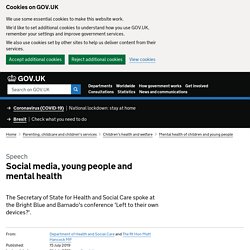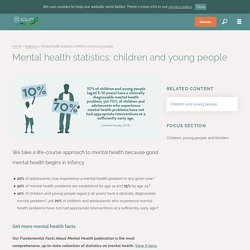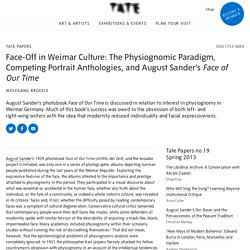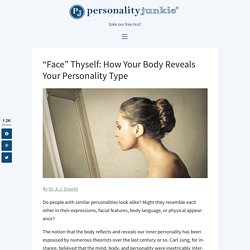

Vaught's Practical Character Reader (1902) Selfie ishness an ethics of self portraiture. The Physiognomic Turn. Social media, young people and mental health. An Irishman, a Barbadian and a Kiwi… Sorry, there’s no punchline – I just wanted to talk about our England cricket team, who I met on the way over here at Downing Street.

And our brilliant England captain, star bowler and star batsman, and this entire generation of England cricketers, who come from so many different backgrounds to play for our country. Return of physiognomy? Facial recognition study says it can identify criminals from looks alone. Two scientists from China's Shanghai Jiao Tong University have drawn ire from the scientific community after producing a study that claims to be able to tell a criminal from a law-abiding citizen in nine cases out of ten, based on a computer algorithm.

Xiaolin Wu and Xi Zhang “collected 1,856 ID photos that satisfy the following criteria: Chinese, male, between ages of 18 and 55, no facial hair, no facial scars or other markings,” 730 of whom were criminals, whose images were provided by the police. The scientists then devised four different machine-learning algorithms, which were fed a proportion of the photo base, and told which ones were criminals, as a means by which to 'train' them.
They were then given the remaining photos, and instructed to identify convicts without any additional cues. The criminals appeared to have possessed some common physical qualities that helped the computer to identify them. Mental health statistics: children and young people. We take a life-course approach to mental health because good mental health begins in infancy. 20% of adolescents may experience a mental health problem in any given year.150% of mental health problems are established by age 14 and 75% by age 24.2 10% of children and young people (aged 5-16 years) have a clinically diagnosable mental problem3, yet 70% of children and adolescents who experience mental health problems have not had appropriate interventions at a sufficiently early age.4 Get more mental health facts Our Fundamental Facts About Mental Health publication is the most comprehensive, up-to-date collection of statistics on mental health.

View it here. 1WHO (2003). Eugenics - HISTORY. Eugenics is the practice or advocacy of improving the human species by selectively mating people with specific desirable hereditary traits.

It aims to reduce human suffering by “breeding out” disease, disabilities and so-called undesirable characteristics from the human population. Early supporters of eugenics believed people inherited mental illness, criminal tendencies and even poverty, and that these conditions could be bred out of the gene pool. Historically, eugenics encouraged people of so-called healthy, superior stock to reproduce and discouraged reproduction of the mentally challenged or anyone who fell outside the social norm. Eugenics was popular in America during much of the first half of the twentieth century, yet it earned its negative association mainly from Adolf Hitler’s obsessive attempts to create a superior Aryan race.
What is eugenics and why are Tory aides interested in it? Boris Johnson is under pressure to sack a 27-year-old adviser who praised the merits of eugenics.

It has been revealed that Andrew Sabisky, who was appointed by Dominic Cummings, the prime minister’s chief adviser, said in 2016: “Eugenics are about selecting ‘for’ good things. Intelligence is largely inherited and correlates with better outcomes: physical health, income, lower mental illness.” Eugenics refers to the belief and practices that aim to improve the genetic quality of a human population by excluding genetic groups judged to be inferior, and promoting genetic groups judged to be superior. As Kenan Malik wrote in The Guardian, eugenicists believe the state should “encourage the ‘enlightened’ to have more children and discourage the lower orders, whether the poor, the disabled or the immigrant, from breeding”. 17th Century Sketches Comparing Human And Animal Faces. These bizarre sketches were made by French painter and art theorist Charles Le Brun (1619 – 1690) who was declared by King Louis XIV as "the greatest French artist of all time".

Charles Le Brun was deeply influenced by the work of Descartes's Passions of the Soul (1649), in which the French philosopher weighted his opinion on the theory of human emotions, a subject that was much debated among natural philosophers since the time of Plato. After speaking on various occasions with the Royal Academy of Painting and Sculpture in Paris, on the subject of General Expression and the Expression of Passions, Le Brun presented a lecture to the Academy on physiognomy, in 1671.
He illustrated his lecture with a series of striking drawings in which he made analogies between human and animal features. Le Brun’s original lecture is lost but his sketches have survived. Face-Off in Weimar Culture: The Physiognomic Paradigm, Competing Portrait Anthologies, and August Sander’s Face of Our Time – Tate Papers. August Sander’s 1929 photobook Face of Our Time (Antlitz der Zeit), and the broader project it initiated, was only one in a series of photographic albums depicting German people published during the last years of the Weimar Republic.

Exploiting the expressive features of the face, the albums attested to the importance and prestige attached to physiognomy in this period. They participated in a visual discourse about what was essential or accidental in the human face, whether any truth about the individual, or the fate of a community, or indeed a whole nation’s culture, was revealed in its citizens’ faces and, if not, whether the difficulty posed by reading contemporary faces was a symptom of cultural degeneration.
Conservative cultural critics lamented that contemporary people wore their dull faces like masks, while some defenders of modernity spoke with similar fervour of the desirability of acquiring a mask-like, blank, impermeable face. Jasper’s critique was timely. International Journal of Communication: The Physiognomic Turn. “Face” Thyself: How Your Body Reveals Your Personality Type. By Dr.

A.J. Drenth Do people with similar personalities look alike? Might they resemble each other in their expressions, facial features, body language, or physical appearance? The notion that the body reflects and reveals our inner personality has been espoused by numerous theorists over the last century or so. Physiognomy: Faces, Bodies, and the “Science” of Human Character. Flashback Friday.

Reader Lindsey H. sent me a copy of a book called Vaught’s Practical Character Reader, apparently published in 1902 and revised in 1907 by Emily H. Vaught. ‘Selfies’ by the world’s first humanoid AI artist to go on display. In 2019, Ai-Da became the world’s first AI humanoid to pick up a pencil and create art without any human input.

Armed with a microchip in her eye, a robotic hand, and a groundbreaking algorithm, the robot can draw and paint from sight, and has since staged her first solo exhibition (raking in a fair amount of cash in the process). Now, Ai-Da has been taught to “look” in a mirror and create self-portraits in her distinctive style. The hyperreal robot artist is set to exhibit a series of these self-portraits – or “selfies” – in a new show at London’s Design Museum. Named after the 19th century mathematician Ada Lovelace, Ai-Da is created by gallery director Aidan Meller and curator Lucy Seal, in collaboration with Oxford University and the British robotics company Engineered Arts.
In an interview with The Times, the creators explain that the new exhibition is supposed to serve as a warning about our reliance on tech-giants in a world driven by data. Most people can’t distinguish between AI and human art, says a new study. A new study that measures how humans perceive artworks generated by artificial intelligence, alongside artworks created by humans, has concluded that a majority of people basically can’t tell the difference.
Published in the journal Empirical Studies in the Arts by researcher Harsha Gangadharbatla, the study was inspired by the sale of “Edmond de Belamy”, an AI-generated portrait by the creative studio Obvious. Hailed as “the future”, the artwork fetched around ten times the average price for a male artist at auction (and 20 times more than artworks by women), going for $432,500 at Christie’s in 2018. It's all Fun and Lollipops 'till someone gets hurt... Since its launch in 2010, Instagram has taken the world by storm, virtually gaining popularity by the second. What originally began as an app that allows users all over the globe to share photos and videos with their followers, in recent years has become a social network that serves as a key advertising tool for companies trying to get their products out to large demographics.
Instagram’s new identity as a marketing superhouse has thus allowed ‘insta-famous’ users, individuals with a considerably high number of followers, to generate profit off of sponsored posts. Even high profile celebrities have added “social media influencer” to their resumes, promoting everything from beauty products to clothing to cars. For instance, reality tv icon Kim Kardashian West, also known as the queen of social media, brings in about $1.27 million per sponsored post.
Neuroscience: why do we see faces in everyday objects? - BBC Future. The Origins of Psychology: History Through the Years. While the psychology of today reflects the discipline's rich and varied history, the origins of psychology differ significantly from contemporary conceptions of the field. In order to gain a full understanding of psychology, you need to spend some time exploring its history and origins.
How did psychology originate? When did it begin? Who were the people responsible for establishing psychology as a separate science? Why Study Psychology History? Freud family. The family of Sigmund Freud, the pioneer of psychoanalysis, lived in Austria and Germany until the 1930s before emigrating to England, Canada and the United States. Several of Freud's descendants have become well known in different fields. Freud's parents and siblings[edit] Why being creative is good for you - BBC Culture. Mhairi McDonald (mhairi0160) - Profile. Body positivity on Instagram and TikTok is a paradox.
In the beginning of 2020, Morayo Ogunbayo was aware that the vast majority of women did not look like Kendall Jenner. As a 19-year-old college student, she knew that to meet American culture’s body standard was to either hit the genetic lottery or have enough money to fake it convincingly. She knew that this ideal was rooted in sexist and Eurocentric beliefs about femininity, that most women fell far short of achieving it, and that that was perfectly normal. Mental health online: why the way we use social media matters.